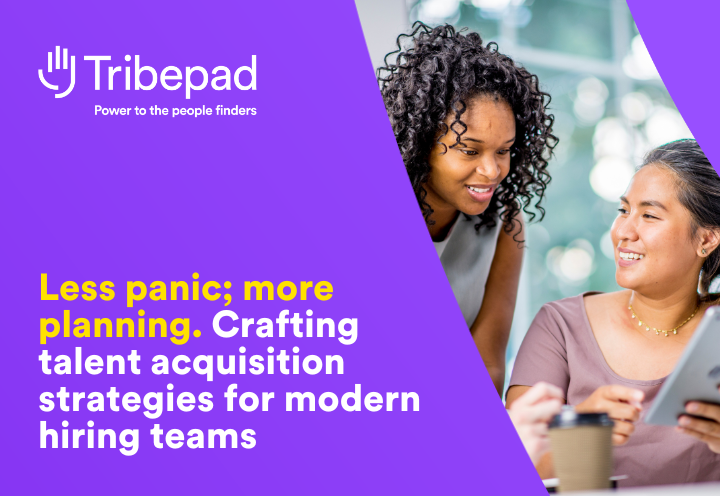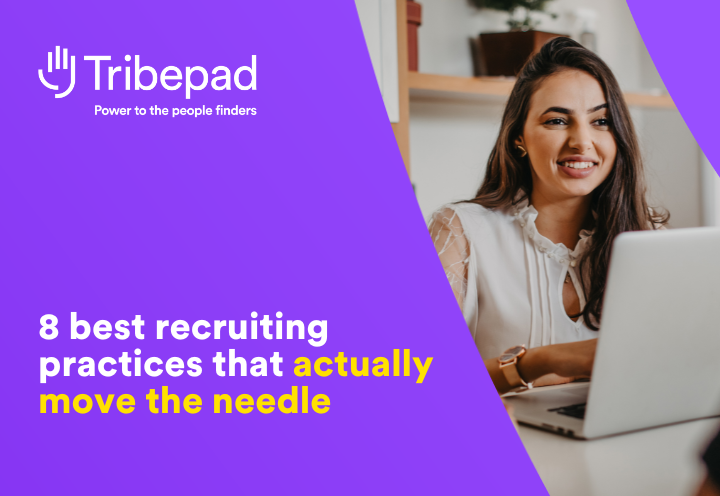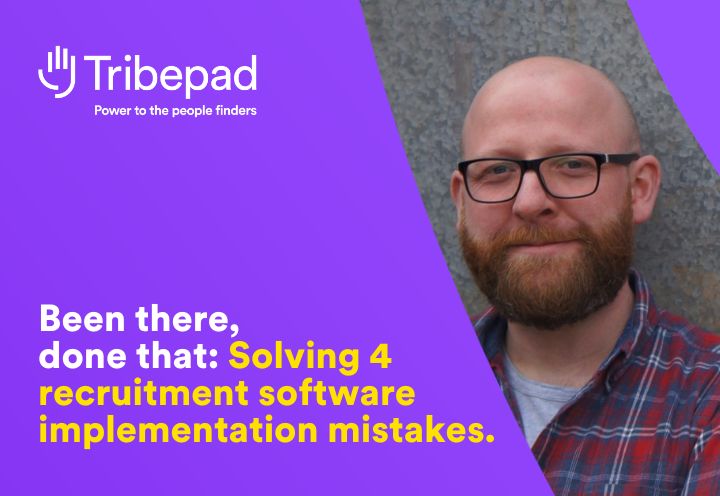AI recruitment is today’s hottest topic for recruiters. But it’s not only a conversation for well-resourced enterprise teams. AI has huge potential for small business recruitment teams to hire fairer, faster, and better. Keep reading for 12 ideas how SMEs can integrate AI into your hiring.
AI recruitment is the phrase on everyone’s lips right now. With money pouring into the space (the AI recruitment market was valued at $630.5 million in 2022, and is projected to grow to $839.5 million by 2028), AI seems likely to totally up-end how we hire.
That’s true for everyone, not just large enterprises. Yes, the big players with gigantic budgets can more readily afford all-singing, all-dancing talent tools that lead the way with AI development.
But small business recruitment teams can also harness AI to create efficiencies, speed things up, remove manual work, improve reach, and remove biases. That is, to hire fairer, faster, and better.
Recruiting Brainfood’s Hung Lee spoke to Tribepad’s Sam Simpson-Oldale and Livero Group’s Neil Ray about how SME recruiters can embrace AI-driven recruitment to improve how you hire.
Watch the webinar here – or keep reading for 12 ideas taken from the session, on how AI could change SMB recruitment.
12 ways SME recruiters could use AI for hiring
1 – Sense-checking job descriptions
Your job description is the foundation for great hiring. If you get this wrong, you might hire someone great – but they’ll be great for a role that doesn’t actually exist. A sure-fire way to increase turnover, waste time and money, damage morale, and hurt your employer brand.
AI could help by:
- Scanning adverts that match your role to highlight similarities and gaps
- Scanning your description against your culture code to see where they align
- Scanning your description against internal roles to flag overlap and gaps
- Scanning against internal performance management data from similar roles
2 – Drafting job adverts
Drafting ads is one quintessential way many small business recruiters are already using AI for recruitment.
One word of warning though. We’re already starting to see an absolute sea of identikit content, where busy recruiters are inputting the same basic prompts to tools like ChatGPT and getting out the same basic output.
(Mind you, that’s actually good news. It’s easier for your job ads to stand out, if you do put the work in.)
To make AI job advert tools work better for you, the quality of your input is super important. Job description? Good. Job description plus culture code? Better. Job description plus culture code plus careers site plus EVP? Great.
And remember that AI is great for drafting not straight-up creating. AI can get you, say, 60% of the way there. The final 40% is where you shine.
Tribepad Gro comes with an integrated Ad Assistant helper, who springs into action when you’re writing job adverts. You write as you normally would, then Ad Assistant scans, scores, and suggests improvements to make your copy more engaging, accessible, readable, and inclusive.
3 – Employer branding support
AI can be enormously helpful in helping you plan, create, and promote employer branding campaigns.
We’ve talked before about why employer branding is so beneficial for SMEs – but we also know EB can feel impossible on your shoestring budget. AI can help SME recruiters make your time and money go further, so you can get that all-important branding content circulating.
But the same advice applies as above. There are hundreds of articles published almost daily saying the exact same things in the exact same ways. That’s not employer branding: that’s white noise.
Quality input is everything here. Start from your story; your mission; your vision; your values. And if you don’t have that stuff yet, that’s where to focus before you create heaps of blogs that don’t align to your brand.
Watch Hung Lee talk about employer branding for SMEs:
4 – Filtering applications
One of the biggest pain points for small business recruiters is high application volume: practically speaking, how do you find enough hours in the day to review applicants?
Especially in today’s market, which is getting increasingly candidate-saturated. Especially with the rise of tools like LazyApply that enable candidates to apply for 1000s of jobs with a click.
This is one area of recruitment where AI really shines. AI is excellent at filtering, sifting, sorting, and prioritising candidates based on your requirements. But again – it’s that emphasis: your requirements. If your requirements are flawed, the AI will operate to flawed logic.
AI can help you accelerate, but it does need a sensible step back first to make sure you’re not running where you shouldn’t walk. Ethical AI development is a must.
One thing the Tribepad team are working on right now is an intelligent AI skills matching tool. This’ll help hiring managers and recruiters codify what the true skills you need are, then match applications accordingly.
It’ll also help candidates codify their skills better, so you’re getting the best applicants for the job – not just the applicants who know how to “sell” themselves.
Watch this space…
5 – Supporting ED&I goals
The whole point of AI, really, is to allow the best bits of humans to shine. But it’s also super helpful to eliminate some of the not-so-good bits, like our subjectivity and tendency towards unconscious biases.
AI can help remove unconscious bias in recruitment and improve workforce diversity – so you can trust you’re hiring based on talent. For example, AI could:
- Anonymise applications
- Anonymise video interviews
- Prioritise applications from diverse backgrounds
- Create talent pools around underrepresented communities
- Offer bespoke support to candidates who might need it
6 – Spotting and flagging AI applications
As Sam points out in the webinar, we don’t believe the answer to candidates’ AI use is blocking AI applications.
That pits recruiter against candidates and pulls us into an endless race to find the best AI tools to “win”, rather than sensitively understanding why candidates might be using AI. AI could a game-changer for neuro-divergent or dyslexic candidates, for example.
But we do believe it’s helpful for recruiters to know when AI has been used. That might have an impact on how you interview, for example, or the skills assessments you want to use. And it could help you spot where candidates may need extra support, so you can help them put their best foot forwards.
7 – Building talent pools
The explosion of AI recruitment means application volume is skyrocketing. Eventually, this’ll mean many organisations are wary of spending money on advertising. Especially smaller organisations with budget restrictions.
Why would you pour money into a channel that creates more problems than it solves?
Instead, Hung reckons most teams will focus their time and money on getting more value from the candidates they already know. AI can contribute by helping understand and group the skills in your candidate database into smart talent pools.
Talent pooling is one of the biggest reasons for smaller organisations to switch from spreadsheets to dedicated talent tech.
Ultimately, spreadsheets are poor for proactive recruitment and involve an enormous amount of manual work. An ATS uses automation and AI to make your life a bazillion times easier.
8 – Composing messages
This is another mainstay of most small business recruitment teams. Even if you’re not using a dedicated ATS, most recruiters are using commercially available tools to compose messages to candidates.
The same point applies though, as everywhere. Quality input makes for quality output. AI learns, it doesn’t know. Don’t expect to input a few prompts and get instant magic out. Treat AI as a drafting tool, not a writing tool.
9 – Candidate outreach calls
More of an idea for the future, but Neil talks about the AI tool he’s built to handle business development calls for his recruitment agency. He uses the tool to make 300 calls a minute, ultimately wrangling meetings with decision-makers that he can handle personally.
It’s an extreme example, but it could have great application for early candidate screening, for instance. Or for roles that require predominantly phone-based recruitment – like miners, or offshore oil and gas folks, as a couple of examples.
10 – Unlock value from your candidate database
One of the biggest sources of gold are old mobile phones, Hung points out. Dumped in landfill and forgotten about. Many recruiters treat their candidate database the same way.
The problem with all of this AI stuff is, everything is data-dependent. And recruiters have often struggled to keep data clean and rich enough to be useful. Especially small business recruiters who’ve got zero bandwidth for extra admin.
AI can help you get more value from your candidate database, by:
- Using advanced algorithms and matching to surface candidates
- Parsing, cleaning, and enriching data automatically
- Building talent pools around key criteria and skills needs
- Automatically encouraging candidates to update their details
- Nurturing candidates with relevant jobs for them
Reactivating candidates who are already in your system is much more efficient than hunting for someone new. Especially when AI-driven recruitment is making it increasingly hard to spot great people on the open market.
11 – Create an AI “twin” to grow hero presence
Did you see Reed Hoffman (LinkedIn co-founder) interviewing his “digital twin”, REID AI? Right now, experiments like this are the playground of billionaires. But the AI world is developing so fast, Hung reckons this could be one to watch for the future.
For lots of SMEs and growing organisations, the CEO/founder is often a major draw with a strong personal brand in their own right. AI could allow you to maximise the impact of these key recruitment assets by turning your important in-house personalities into AI twins.
12 – Real-time AI recruitment optimisation
We’re getting closer and closer to real-time optimisation already, with tools like programmatic job advert matching optimising spend based on what’s working. Ultimately, this same principle could apply throughout the recruitment lifecycle.
AI excels at analysing, sifting, and drawing conclusions from large datasets at lightning speed. At a birds’ eye level, that describes the recruitment ecosystem: lots of moving parts generating lots of data.
Depending on the tools you use, AI should become able to look across your processes and see at a glance what’s working, what’s not, where to improve, and implement those improvements.
There’s still plenty of scope for development with AI here, but to a large extent this is already one major benefit of using Tribepad Gro.
With complete recruitment reporting, the ATS looks across your processes and pulls those insights into easy, intuitive reports that show you inefficiencies and improvement opportunities.
AI can be powerful – but it’s only as good as the people behind it
A good way to think of AI is that it’s similar to a junior resourcer. It’s a highly efficient, highly intelligent intern but it’s not an expert.
It needs guidance and direction. It needs training around your specific processes, values, and brand. It needs oversight and management, to ensure it stays on-track. And you don’t let it make big decisions alone.
AI recruitment is exciting. Lots of the hype is justifiable. As a team, we’re enormously excited about the potential for AI to make recruitment even fairer, faster, and better for everyone.
But it’s crucial that teams don’t treat AI as more than it is. It’s not a replacement for human decision-making. It’s a supplement. One that can help busy SME recruiters regain hours in the day, so you can scale your impact.
Tribepad Gro is ready built, ready-to-go recruitment software for growing teams. Take your recruitment to the next level. Get your free recruitment diagnostic session with Tribepad consultants Dan and Hayley to learn what could be stalling your growth.




